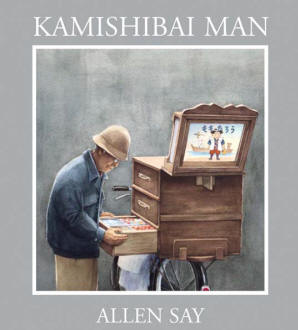by Allen Say

Caldecott Award winner Allen Say's book is a remembrance of a time in Japan when Kamishibai men were important in children's lives and a commemoration of the power of these memories.
Autographed book: $20.00
In the afterword to this heart-warming
story, we learn that kamishibai, a traveling 'paper theater',
was a well-loved form of entertainment for children in Japan,
mainly from the 1930s to the 1950s, when television superceded
it. Allen Say introduces kamishibai as being very much tied up
with his own childhood and he brings it to life here for the present
younger generation with this story of an old man who has a sudden
urge to take his kamishibai back to town after many years. Children
play an important part in the story and young readers will empathize
with them-especially the small boy who is not part of the crowd.
The Kamishibai Man of this story
is called simply Jiichan, meaning Grandpa: he belongs to all children
who will listen to his stories. His wife is Baachan, Grandma;
and she too has an important role, albeit behind the scenes: she
makes the sweets that Jiichan hands out to his audience. As the
book unfolds, the story shifts almost imperceptibly from the present
to the past and his reminiscences of kamishibai themselves become
the theater's storyboards. He takes us, his readers, with him
as his audience and lulls us with these reminiscences - until
we are jolted back into the present by the shouts from the audience
in the story-an audience not of children but of adults reglimpsing
their lost childhood. The suggestive inclusion of two children
hanging out of a window is evocative of the hope of a revival
of kamishibai for a new generation. Indeed, the book explores
how things we love but take for granted in our childhood become
precious in later years; and the importance of handing down our
cultural heritage to future generations. Jiichan returns home
at the end of the day, a day which has been caught on film and
broadcast via the very medium that brought about the demise of
kamishibai. Thus, another theme of the book is how innovation
and change can appear threatening but through time and adjustment
there is room for all. Everything comes full circle and Jiichan
will go back to the city the very next day to tell his stories.
Say's illustrations convey the gentle, timeless quality of Jiichan's
home; the looming menace of the (to him) unrecognizable city;
and the nostalgic glow of the kamishibai. He conveys the shifts
in the story through visual changes in tones: you can almost feel
the warmth of sunshine and hear the babble of children's voices-and
we realize through the illustrations rather than the text that
Jiichan is a young man again. Details emerge with each rereading.
Indeed, this is one of those special children's books, which can
be read again and again, and that adults will never tire of reading
as a bedtime story. The only problem will be looking for a 'real'
kamishibai man.
Marjorie Coughlan, June 2006
PaperTigers Reader
www.papertigers.org
|






